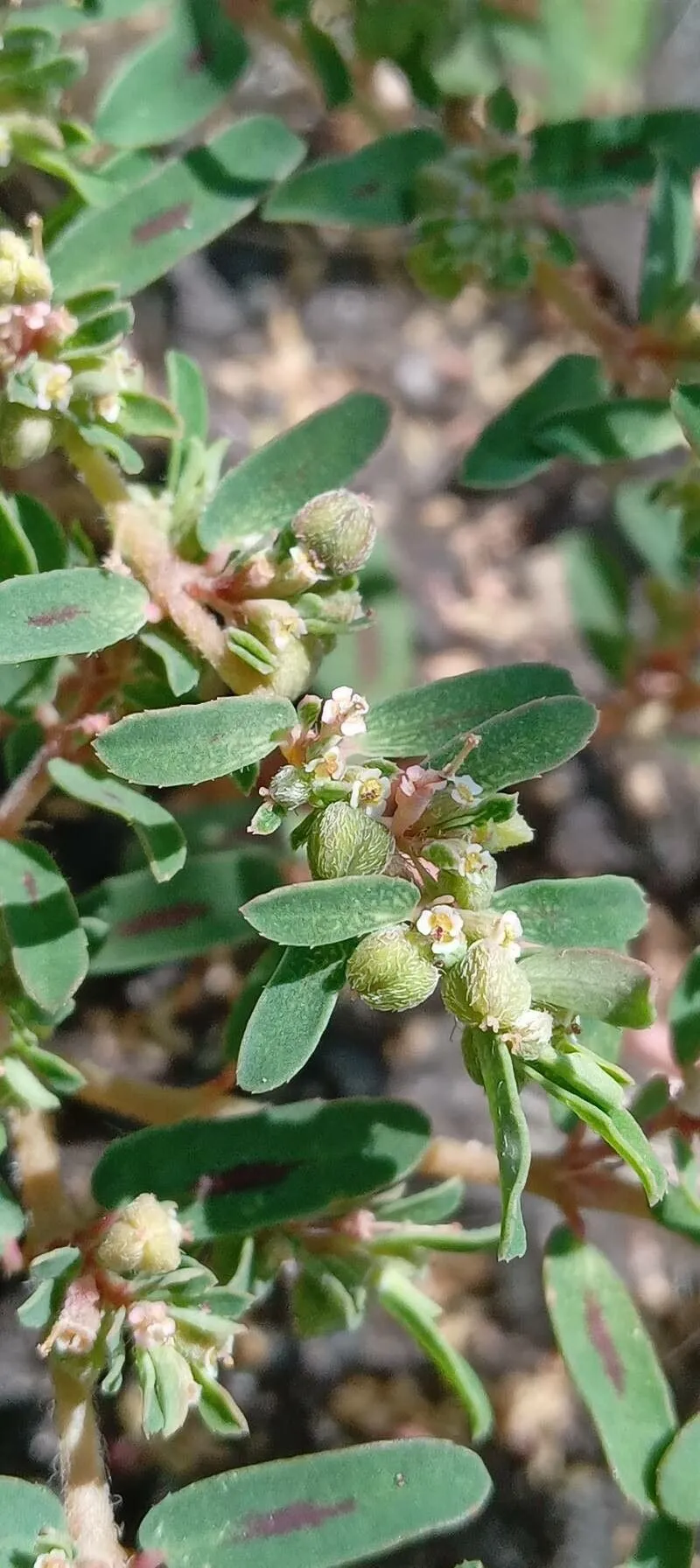
Author: L.
Bibliography: Sp. Pl.: 455 (1753)
Year: 1753
Status: accepted
Rank: species
Genus: Euphorbia
Vegetable: Unknown
Observations: SE. Canada to Belize, Cuba, Bahamas
Spotted sandmat, known scientifically as Euphorbia maculata, is a fascinating plant species belonging to the Euphorbiaceae family. First described in 1753, this plant’s natural distribution stretches from Southeastern Canada, through parts of the United States, and extending as far south as Belize, Cuba, and the Bahamas. Its resilience and adaptability have allowed it to thrive in various climates and conditions across this extensive range.
This annual herb is often recognized by its characteristic spotted leaves and sprawling growth habit. Euphorbia maculata typically grows flat against the ground and forms dense mats, making it a prevalent and easily noticeable species in its native habitats. The plant’s leaves are small, ovate, and typically have a dark spot in the center, which gives the spotted sandmat its common name. These leaves are arranged oppositely on reddish stems, which often exude a milky sap when broken, a trait common to many members of the Euphorbia genus.
The flowers of Euphorbia maculata are minute and inconspicuous, clustered in small cyathia that are characteristic of the Euphorbia family. Despite their diminutive size, these flowers are crucial for the plant’s reproduction and ecological role, providing nectar for various pollinators. Following pollination, the plant produces small, three-lobed seed capsules that eventually burst open to disperse the seeds.
In its native range, spotted sandmat can be found in a variety of habitats, from rocky outcrops and open fields to disturbed areas such as roadsides and urban environments. Its ability to colonize disturbed soils makes it both a resilient native plant and, in some cases, a weed of concern to gardeners and farmers.
Beyond its ecological role, spotted sandmat also has a place in traditional medicine. Indigenous peoples and early settlers have used various parts of the plant for their purported medicinal properties, although modern scientific validation is limited.
In summary, Euphorbia maculata is a noteworthy plant due to its widespread distribution, distinct morphology, and adaptive capabilities. As a member of the diverse Euphorbiaceae family, it contributes to the biodiversity and ecological complexity of the regions it inhabits.
Deu: gefleckte zwergwolfsmilch, gefleckte wolfsmilch
Eng: milk purslane, milk-purslane, prostrate spurge, spotted sandmat, spotted spurge, blotched spurge, creeping spurge, hairy-fruited spurge, milk spurge
Dan: plet-vortemælk
Swe: fläcktörel
Spa: lechosilla
Nld: straatwolfsmelk
Fra: euphorbe maculée, euphorbe tachetée, ricinelle maculée
Cym: llaethlys brych
En: Spotted sandmat, Spotted spurge, Milk-purslane, Large spurge, Milk purslane, Prostrate spurge, Blotched spurge, Creeping spurge, Hairy-fruited spurge, Milk spurge
Ar: فربيون ملطخ
Az: Xallı südləyən
Ca: Lleterola maculada
Zh: 斑地錦
Cs: Pryšec skvrnitý
Da: Plet-vortemælk
Nl: Straatwolfsmelk
Fi: Täplätyräkki
Fr: Euphorbe maculée, Euphorbe tachetée, Ricinelle maculée, Euphorbe à feuilles tachées, Euphorbe de Jovet
De: Gefleckte Wolfsmilch, Gefleckte Zwergwolfsmilch, Gefleckte Schiefblattwolfsmilch
He: חלבלוב נטוי
It: Euforbia macchiata
Ja: Ko-nishiki-sō
Ru: Молочай пятнистый
Sk: Mliečnik škvrnitý
Es: Lechosilla
Sv: Fläcktörel
Zh-tw: 斑地錦
Cy: Llaethlys brych
© copyright of the Board of Trustees of the Royal Botanic Gardens, Kew.
© copyright of the Board of Trustees of the Royal Botanic Gardens, Kew.
© copyright of the Board of Trustees of the Royal Botanic Gardens, Kew.
Taken Jul 31, 2019 by Jean Meunier (cc-by-sa)
Taken Aug 27, 2022 by Fabrice Rubio (cc-by-sa)
Taken Jul 31, 2022 by Fabrice Rubio (cc-by-sa)
Taken Aug 16, 2022 by Fabrice Rubio (cc-by-sa)
Taken Jul 31, 2022 by Fabrice Rubio (cc-by-sa)
Taken Sep 28, 2019 by Llandrich anna (cc-by-sa)
Taken Oct 15, 2016 by huy HO (cc-by-sa)
Taken Jul 31, 2022 by Fabrice Rubio (cc-by-sa)
Taken Aug 16, 2022 by Fabrice Rubio (cc-by-sa)
Taken Jul 31, 2022 by Fabrice Rubio (cc-by-sa)
Taken Sep 28, 2019 by Llandrich anna (cc-by-sa)
Taken Jul 31, 2022 by Fabrice Rubio (cc-by-sa)
Taken Aug 16, 2022 by Fabrice Rubio (cc-by-sa)
Taken Aug 27, 2022 by Fabrice Rubio (cc-by-sa)
Taken Jul 31, 2022 by Fabrice Rubio (cc-by-sa)
Taken Oct 15, 2005 by Photoflora – Benoit BOCK (©)
Taken Nov 4, 2021 by Llandrich anna (cc-by-sa)
Taken Sep 28, 2019 by Llandrich anna (cc-by-sa)
Taken Aug 27, 2022 by Fabrice Rubio (cc-by-sa)
Taken Sep 28, 2019 by Llandrich anna (cc-by-sa)
Taken Jul 20, 2020 by de Juana Eduardo (cc-by-sa)
Taken Jul 26, 2021 by Sarya Mu (cc-by-sa)
Taken Sep 18, 2011 by Tela Botanica − Bertrand BUI (cc-by-sa)
Taken Aug 10, 2022 by Mihai Doro (cc-by-sa)
Taken Sep 1, 2022 by E C (cc-by-sa)
Taken Sep 15, 2017 by Photoflora – Benoit BOCK (©)
Taken Jul 4, 2011 by Tela Botanica − David MERCIER (cc-by-sa)
Taken Aug 1, 2012 by Tela Botanica − Emmanuel STRATMAINS (cc-by-sa)
Taken Jul 29, 2021 by Pietro Brignoli (cc-by-sa)
Taken Sep 11, 2021 by Frédérique Berato (cc-by-sa)
Family: Myrtaceae Author: (F.Muell.) K.D.Hill & L.A.S.Johnson Bibliography: Telopea 6: 402 (1995) Year: 1995 Status:…
Family: Rubiaceae Author: Pierre ex A.Froehner Bibliography: Notizbl. Bot. Gart. Berlin-Dahlem 1: 237 (1897) Year:…
Family: Sapindaceae Author: Koidz. Bibliography: J. Coll. Sci. Imp. Univ. Tokyo 32(1): 38 (1911) Year:…
Family: Asteraceae Author: A.Gray Bibliography: Pacif. Railr. Rep.: 107 (1857) Year: 1857 Status: accepted Rank:…
Family: Fabaceae Author: Medik. Bibliography: Vorles. Churpfälz. Phys.-Ökon. Ges. 2: 398 (1787) Year: 1787 Status:…
Family: Aspleniaceae Author: (Cav.) Alston Bibliography: Bull. Misc. Inform. Kew 1932: 309 (1932) Year: 1932…